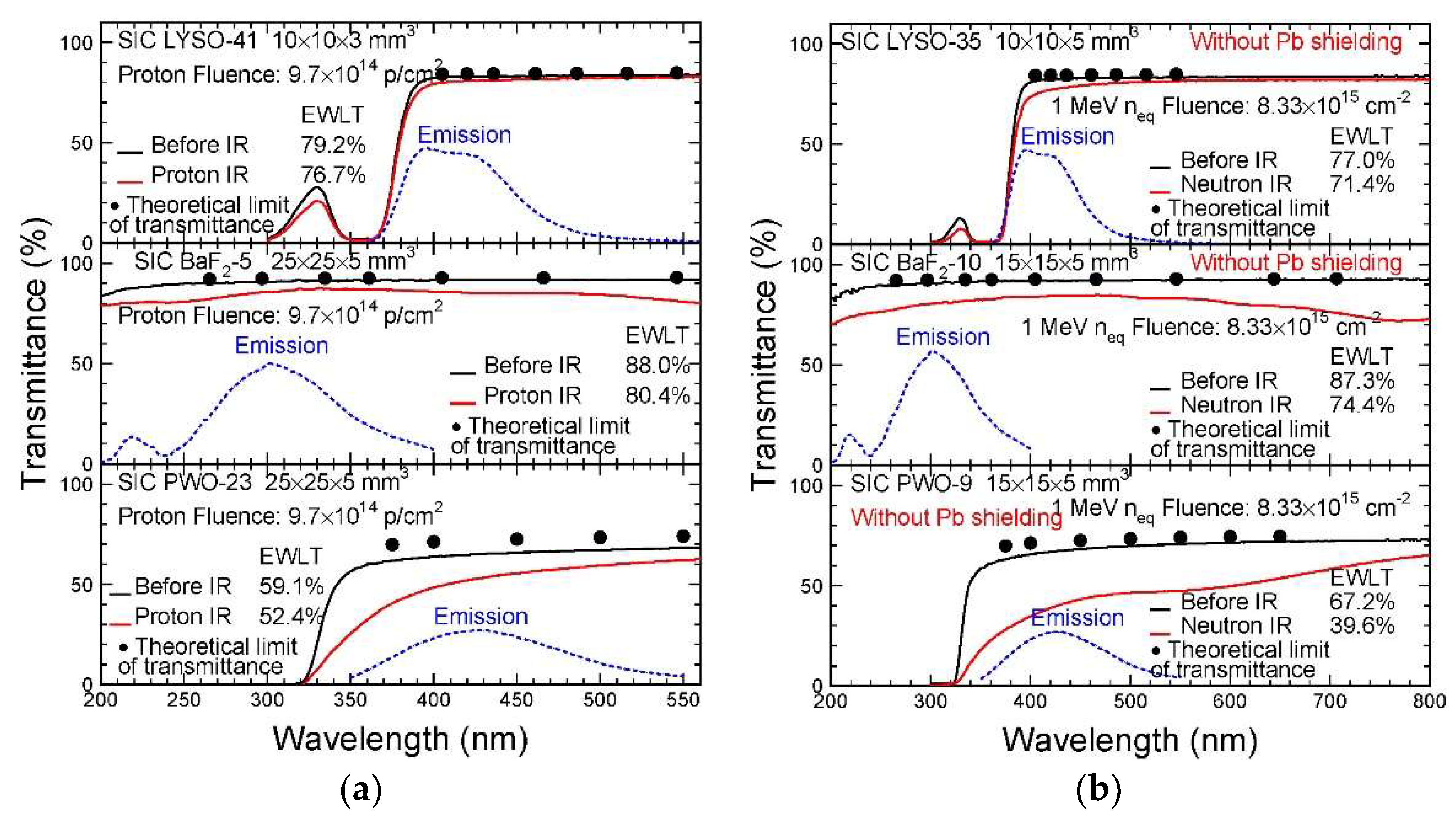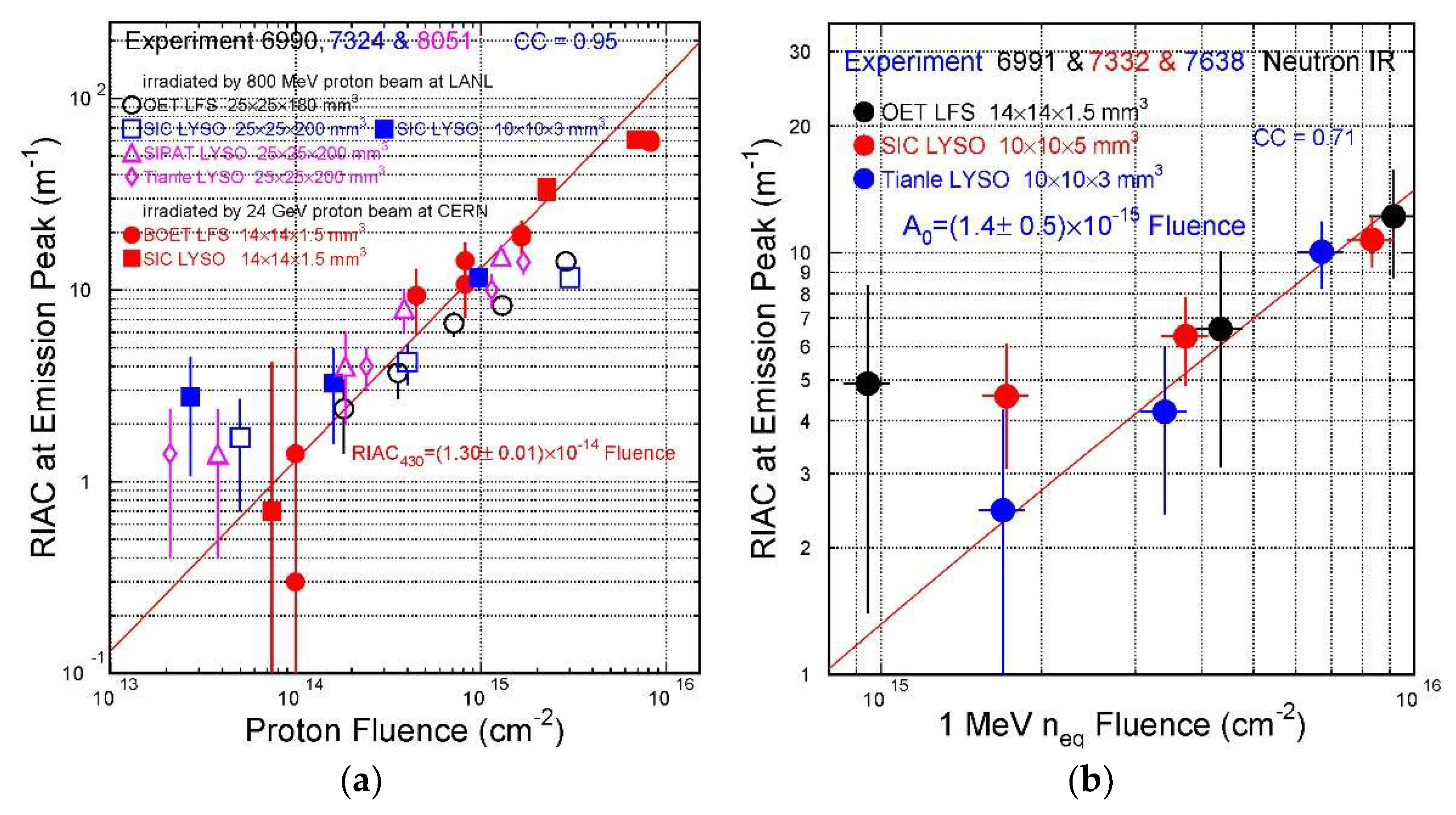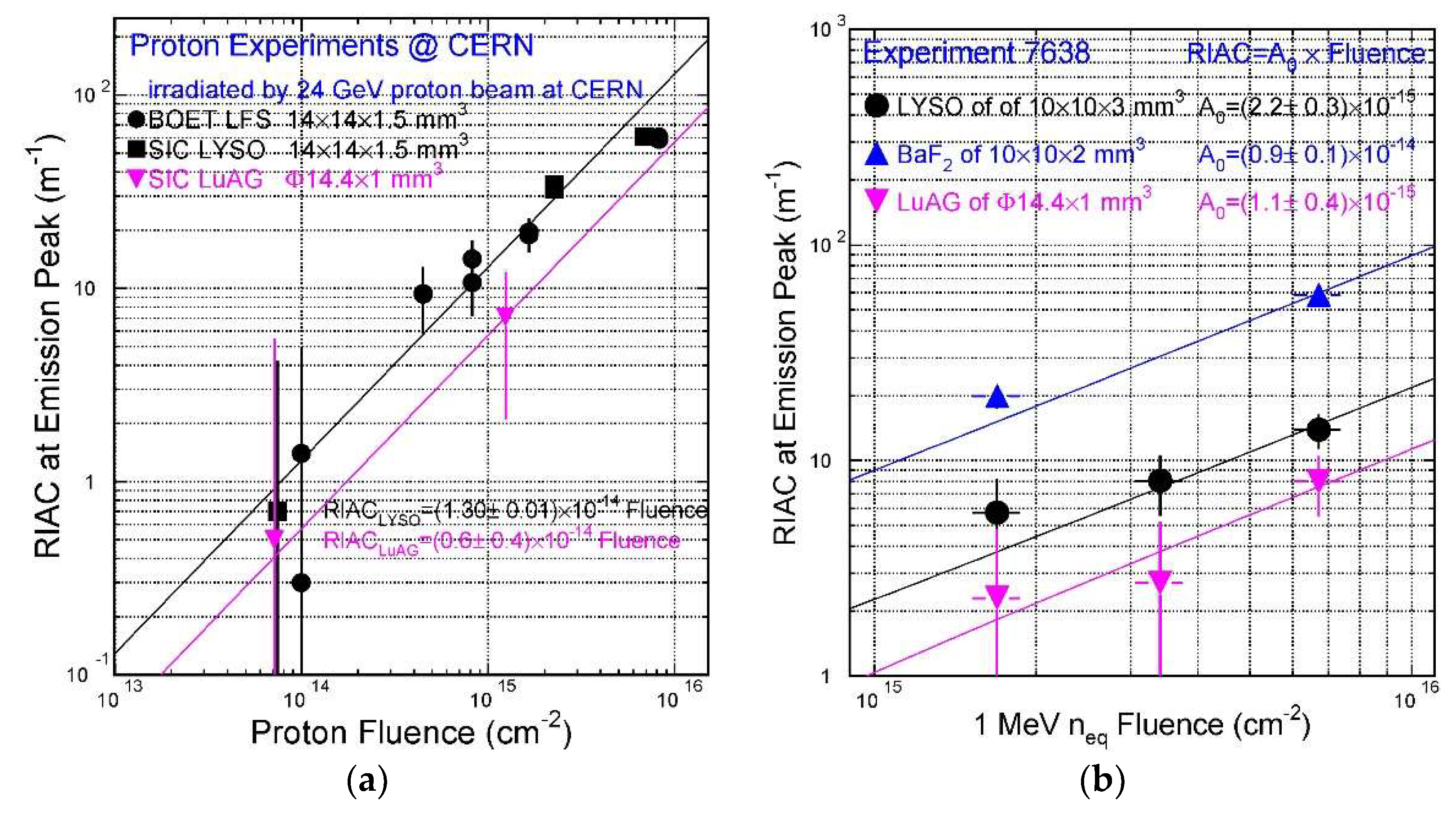Hadron-Induced Radiation Damage in Fast Heavy Inorganic Scintillators
Abstract
1. Introduction
2. Materials and Methods
3. Results and Discussion
4. Conclusions
Author Contributions
Funding
Data Availability Statement
Acknowledgments
Conflicts of Interest
References
- Aleksa, M.; Allport, P.; Bosley, R.; Faltova, J.; Gentil, J.; Goncalo, R.; Helsens, C.; Henriques, A.; Karyukhin, A.; Kieseler, J.; et al. Calorimeters for the FCC-Hh. arXiv 2019, arXiv:1912.09962. [Google Scholar]
- Butler, J.N.; Tabarelli de Fatis, T. A MIP Timing Detector for the CMS Phase-2 Upgrade; CMS Collaboration: Geneva, Switzerland, 2019. [Google Scholar]
- Pezzullo, G.; Budagov, J.; Carosi, R.; Cervelli, F.; Cheng, C.; Cordelli, M.; Corradi, G.; Davydov, Y.; Echenard, B.; Giovannella, S.; et al. The LYSO Crystal Calorimeter for the Mu2e Experiment. J. Instrum. 2014, 9, C03018. [Google Scholar] [CrossRef]
- Oishi, K. An LYSO Electromagnetic Calorimeter for COMET at J-Park. In Paper O47-4 Presented in IEEE NSS 2014; IEEE: Seattle, WA, USA, 2014. [Google Scholar]
- Zhang, S.N.; Adriani, O.; Albergo, S.; Ambrosi, G.; An, Q.; Bao, T.W.; Battiston, R.; Bi, X.J.; Cao, Z.; Chai, J.Y.; et al. The High Energy Cosmic-Radiation Detection (HERD) Facility Onboard China’s Space Station; Takahashi, T., den Herder, J.-W.A., Bautz, M., Eds.; SPIE: Montreal, QC, Canada, 2014; p. 91440X. [Google Scholar]
- Anderson, T.; Barbera, T.; Blend, D.; Chigurupati, N.; Cox, B.; Debbins, P.; Dubnowski, M.; Herrmann, M.; Hu, C.; Ford, K.; et al. RADiCAL: Precision-Timing, Ultracompact, Radiation-Hard Electromagnetic Calorimetry. arXiv 2022, arXiv:2203.12806. [Google Scholar] [CrossRef]
- Abusalma, F.; Ambrose, D.; Artikov, A.; Bernstein, R.; Blazey, G.C.; Bloise, C.; Boi, S.; Bolton, T.; Bono, J.; Bonventre, R.; et al. Expression of Interest for Evolution of the Mu2e Experiment. arXiv 2018, arXiv:1802.02599. [Google Scholar]
- Auffray, E.; Barysevich, A.; Fedorov, A.; Korjik, M.; Koschan, M.; Lucchini, M.; Mechinski, V.; Melcher, C.L.; Voitovich, A. Radiation Damage of LSO Crystals under γ- and 24GeV Protons Irradiation. Nucl. Instrum. Methods Phys. Res. A 2013, 721, 76–82. [Google Scholar] [CrossRef]
- Derdzyan, M.V.; Ovanesyan, K.L.; Petrosyan, A.G.; Belsky, A.; Dujardin, C.; Pedrini, C.; Auffray, E.; Lecoq, P.; Lucchini, M.; Pauwels, K. Radiation Hardness of LuAG:Ce and LuAG:Pr Scintillator Crystals. J. Cryst. Growth 2012, 361, 212–216. [Google Scholar] [CrossRef]
- Petrosyan, A.G.; Ovanesyan, K.L.; Derdzyan, M.V.; Ghambaryan, I.; Patton, G.; Moretti, F.; Auffray, E.; Lecoq, P.; Lucchini, M.; Pauwels, K.; et al. A Study of Radiation Effects on LuAG:Ce(Pr) Co-Activated with Ca. J. Cryst. Growth 2015, 430, 46–51. [Google Scholar] [CrossRef]
- Shen, Y.; Feng, X.; Shi, Y.; Vedda, A.; Moretti, F.; Hu, C.; Liu, S.; Pan, Y.; Kou, H.; Wu, L. The Radiation Hardness of Pr:LuAG Scintillating Ceramics. Ceram. Int. 2014, 40, 3715–3719. [Google Scholar] [CrossRef]
- Dissertori, G.; Luckey, D.; Nessi-Tedaldi, F.; Pauss, F.; Wallny, R. Performance Studies of Scintillating Ceramic Samples Exposed to Ionizing Radiation. In Proceedings of the 2012 IEEE Nuclear Science Symposium and Medical Imaging Conference Record (NSS/MIC), Anaheim, CA, USA, 29 October–3 November 2012; pp. 305–307. [Google Scholar]
- Dormenev, V.; Korjik, M.; Kuske, T.; Mechinski, V.; Novotny, R.W. Comparison of Radiation Damage Effects in PWO Crystals Under 150 MeV and 24 GeV High Fluence Proton Irradiation. IEEE Trans. Nucl. Sci. 2014, 61, 501–506. [Google Scholar] [CrossRef]
- The CMS Electromagnetic Calorimeter Group; Adzic, P.; Almeida, N.; Andelin, D.; Anicin, I.; Antunovic, Z.; Arcidiacono, R.; Arenton, M.W.; Auffray, E.; Argiro, S.; et al. Radiation Hardness Qualification of PbWO4 Scintillation Crystals for the CMS Electromagnetic Calorimeter. J. Instrum. 2010, 5, P03010. [Google Scholar] [CrossRef]
- Dissertori, G.; Perez, C.M.; Nessi-Tedaldi, F. A FLUKA Study towards Predicting Hadron-Specific Damage Due to High-Energy Hadrons in Inorganic Crystals for Calorimetry. J. Instrum. 2020, 15, P06006. [Google Scholar] [CrossRef]
- Dissertori, G.; Luckey, D.; Nessi-Tedaldi, F.; Pauss, F.; Quittnat, M.; Wallny, R.; Glaser, M. Results on Damage Induced by High-Energy Protons in LYSO Calorimeter Crystals. Nucl. Instrum. Methods Phys. Res. A 2014, 745, 1–6. [Google Scholar] [CrossRef][Green Version]
- Dissertori, G.; Lecomte, P.; Luckey, D.; Nessi-Tedaldi, F.; Pauss, F.; Otto, Th.; Roesler, S.; Urscheler, Ch. A Study of High-Energy Proton Induced Damage in Cerium Fluoride in Comparison with Measurements in Lead Tungstate Calorimeter Crystals. Nucl. Instrum. Methods Phys. Res. A 2010, 622, 41–48. [Google Scholar] [CrossRef][Green Version]
- Lucchini, M.T.; Pauwels, K.; Blazek, K.; Ochesanu, S.; Auffray, E. Radiation Tolerance of LuAG:Ce and YAG:Ce Crystals Under High Levels of Gamma- and Proton-Irradiation. IEEE Trans. Nucl. Sci. 2016, 63, 586–590. [Google Scholar] [CrossRef]
- Nessi-Tedaldi, F. Studies of the Effect of Charged Hadrons on Lead Tungstate Crystals. J. Phys. Conf. Ser. 2009, 160, 012013. [Google Scholar] [CrossRef]
- Dissertori, G.; Luckey, D.; Nessi-Tedaldi, F.; Pauss, F.; Wallny, R.; Spikings, R.; van der Lelij, R.; Arnau Izquierdo, G. A Visualization of the Damage in Lead Tungstate Calorimeter Crystals after Exposure to High-Energy Hadrons. Nucl. Instrum. Methods Phys. Res. A 2012, 684, 57–62. [Google Scholar] [CrossRef]
- Lecomte, P.; Luckey, D.; Nessi-Tedaldi, F.; Pauss, F. High-Energy Proton Induced Damage Study of Scintillation Light Output from Calorimeter Crystals. Nucl. Instrum. Methods Phys. Res. A 2006, 564, 164–168. [Google Scholar] [CrossRef]
- Huhtinen, M.; Lecomte, P.; Luckey, D.; Nessi-Tedaldi, F.; Pauss, F. High-Energy Proton Induced Damage in PbWO4 Calorimeter Crystals. Nucl. Instrum. Methods Phys. Res. A 2005, 545, 63–87. [Google Scholar] [CrossRef]
- Auffray, E.; Korjik, M.; Singovski, A. Experimental Study of Lead Tungstate Scintillator Proton-Induced Damage and Recovery. IEEE Trans. Nucl. Sci. 2012, 59, 2219–2223. [Google Scholar] [CrossRef][Green Version]
- Batarin, V.A.; Brennan, T.; Butler, J.; Cheung, H.; Datsko, V.S.; Davidenko, A.M.; Derevschikov, A.A.; Dzhelyadin, R.I.; Fomin, Y.V.; Frolov, V.; et al. Study of Radiation Damage in Lead Tungstate Crystals Using Intense High-Energy Beams. Nucl. Instrum. Methods Phys. Res. A 2003, 512, 488–505. [Google Scholar] [CrossRef]
- Yang, F.; Zhang, L.; Zhu, R.-Y.; Kapustinsky, J.; Nelson, R.; Wang, Z. Proton Induced Radiation Damage in Fast Crystal Scintillators. Nucl. Instrum. Methods Phys. Res. A 2016, 824, 726–728. [Google Scholar] [CrossRef]
- Yang, F.; Zhang, L.; Zhu, R.-Y.; Kapustinsky, J.; Nelson, R.; Wang, Z. Proton-Induced Radiation Damage in Fast Crystal Scintillators. IEEE Trans. Nucl. Sci. 2017, 64, 665–672. [Google Scholar] [CrossRef]
- Yang, F.; Zhang, L.; Zhu, R.-Y.; Kapustinsky, J.; Nelson, R.; Wang, Z. Proton-Induced Radiation Damage in BGO, LFS, PWO and a LFS/W/Quartz Capillary Shashlik Cell. In Proceedings of the 2016 IEEE Nuclear Science Symposium, Medical Imaging Conference and Room-Temperature Semiconductor Detector Workshop (NSS/MIC/RTSD), Strasbourg, France, 29 October–6 November 2016; pp. 1–4. [Google Scholar]
- Hu, C.; Yang, F.; Zhang, L.; Zhu, R.-Y.; Kapustinsky, J.; Nelson, R.; Wang, Z. Proton-Induced Radiation Damage in BaF2, LYSO, and PWO Crystal Scintillators. IEEE Trans. Nucl. Sci. 2018, 65, 1018–1024. [Google Scholar] [CrossRef]
- Chipaux, R.; Borizevich, A.; Dujardin, C.; Lecocq, P.; Korzhik, M.V. Behaviour of PWO Scintillators after High Fluence Neutron Irradiation. In Proceedings of the 8th International Conference on Inorganic Scintillators and Their Applications, Alushta, Ukraine, 19–23 September 2005; pp. 369–371. [Google Scholar]
- Baranov, V.; Davydov, Y.I.; Vasilyev, I.I. Light Outputs of Yttrium Doped BaF2 Crystals Irradiated with Neutrons. J. Instrum. 2022, 17, P01036. [Google Scholar] [CrossRef]
- Hu, C.; Yang, F.; Zhang, L.; Zhu, R.-Y.; Kapustinsky, J.; Mocko, M.; Nelson, R.; Wang, Z. Neutron-Induced Radiation Damage in BaF2, LYSO/LFS and PWO Crystals. J. Phys. Conf. Ser. 2019, 1162, 012020. [Google Scholar] [CrossRef]
- Hu, C.; Yang, F.; Zhang, L.; Zhu, R.-Y.; Kapustinsky, J.; Mocko, M.; Nelson, R.; Wang, Z. Neutron-Induced Radiation Damage in LYSO, BaF2, and PWO Crystals. IEEE Trans. Nucl. Sci. 2020, 67, 1086–1092. [Google Scholar] [CrossRef]
- Hu, C.; Zhang, L.; Zhu, R.-Y.; Li, J.; Jiang, B.; Kapustinsky, J.; Mocko, M.; Nelson, R.; Li, X.; Wang, Z. Hadron-Induced Radiation Damage in LuAG:Ce Scintillating Ceramics. IEEE Trans. Nucl. Sci. 2022, 69, 181–186. [Google Scholar] [CrossRef]
- Ma, D.; Zhu, R. Light Attenuation Length of Barium Fluoride Crystals. Nucl. Instrum. Methods Phys. Res. A 1993, 333, 422–424. [Google Scholar] [CrossRef]
- Yang, F.; Zhang, L.; Zhu, R.-Y. Gamma-Ray Induced Radiation Damage Up to 340 Mrad in Various Scintillation Crystals. IEEE Trans. Nucl. Sci. 2016, 63, 612–619. [Google Scholar] [CrossRef]
- Sobolev, B.P.; Krivandina, E.A.; Derenzo, S.E.; Moses, W.W.; West, A.C. Suppression of BaF2 Slow Component of X-RAY Luminescence in Non-Stoichiometric Ba0.9R0.1F2.1 Crystals (R = Rare Earth Element). MRS Proc. 1994, 348, 277. [Google Scholar] [CrossRef]
- Radzhabov, E.; Istomin, A.; Nepomnyashikh, A.; Egranov, A.; Ivashechkin, V. Exciton Interaction with Impurity in Barium Fluoride Crystals. Nucl. Instrum. Methods Phys. Res. A 2005, 537, 71–75. [Google Scholar] [CrossRef]
- Myasnikova, A.S.; Radzhabov, E.A.; Egranov, A.v. Extrinsic Luminescence of BaF2:R3+ Crystals (R3+ = La3+, Y3+, Yb3+). Phys. Solid State 2008, 50, 1644–1647. [Google Scholar] [CrossRef]
- Chen, J.; Yang, F.; Zhang, L.; Zhu, R.-Y.; Du, Y.; Wang, S.; Sun, S.; Li, X. Slow Scintillation Suppression in Yttrium Doped BaF2 Crystals. IEEE Trans. Nucl. Sci. 2018, 65, 2147–2151. [Google Scholar] [CrossRef]
- Gundacker, S.; Pots, R.H.; Nepomnyashchikh, A.; Radzhabov, E.; Shendrik, R.; Omelkov, S.; Kirm, M.; Acerbi, F.; Capasso, M.; Paternoster, G.; et al. Vacuum Ultraviolet Silicon Photomultipliers Applied to BaF2 Cross-Luminescence Detection for High-Rate Ultrafast Timing Applications. Phys. Med. Biol. 2021, 66, 114002. [Google Scholar] [CrossRef] [PubMed]






| Experiment | Samples | Dimension (mm3) | Fluence (cm−2) |
|---|---|---|---|
| CERN PS-IRRAD | 4 × SIC LYSO | 14 × 14 × 1.5 | 7.4 × 1013–6.9 × 1015 |
| 10 × BOET LFS | 14 × 14 × 1.5 | 1.0 × 1014–8.2 × 1015 | |
| 2 × SIC LuAG | Φ14.4 × 1 | 7.1 × 1013–1.2 × 1015 | |
| LANSCE-p-6990 | OET LFS | 25 × 25 × 180 | 1.8 × 1014–2.9 × 1015 |
| LANSCE-p-7324 | SIC LYSO | 25 × 25 × 200 | 5.0 × 1013–3.0 × 1015 |
| 9 × SIC LYSO | 10 × 10 × 3 | 2.7 × 1013–9.7 × 1014 | |
| 6 × SIC BaF2 | 25 × 25 × 5 | 2.7 × 1013–9.7 × 1014 | |
| 6 × SIC PWO | 25 × 25 × 5 | 2.7 × 1013–9.7 × 1014 | |
| LANSCE-p-8051 | SIPAT LYSO | 25 × 25 × 200 | 3.8 × 1013–1.6 × 1015 |
| Tianle LYSO | 25 × 25 × 200 | 2.2 × 1013–1.8 × 1015 | |
| LANSCE-n-6991 | 18 × OET LFS | 14 × 14 × 1.5 | 9.4 × 1014–9.2 × 1015 |
| LANSCE-n-7332 | 12 × SIC LYSO | 10 × 10 × 5 | 1.7 × 1015–8.3 × 1015 |
| 12 × SIC BaF2 | 15 × 15 × 5 | 1.7 × 1015–8.3 × 1015 | |
| 12 × SIC PWO | 15 × 15 × 5 | 1.7 × 1015–8.3 × 1015 | |
| LANSCE-n-7638 | 6 × SIC LYSO | 10 × 10 × 3 | 1.7 × 1015–6.7 × 1015 |
| 6 × Tianle LYSO | 10 × 10 × 3 | 1.7 × 1015–6.7 × 1015 | |
| 8 × BGRI BaF2 | 10 × 10 × 2 | 1.7 × 1015–6.7 × 1015 | |
| 8 × SIC BaF2 | 10 × 10 × 2 | 1.7 × 1015–6.7 × 1015 | |
| 3 × SIC LuAG | Φ14.4 × 1 | 1.7 × 1015–6.7 × 1015 |
Publisher’s Note: MDPI stays neutral with regard to jurisdictional claims in published maps and institutional affiliations. |
© 2022 by the authors. Licensee MDPI, Basel, Switzerland. This article is an open access article distributed under the terms and conditions of the Creative Commons Attribution (CC BY) license (https://creativecommons.org/licenses/by/4.0/).
Share and Cite
Hu, C.; Yang, F.; Zhang, L.; Zhu, R.-Y.; Kapustinsky, J.; Li, X.; Mocko, M.; Nelson, R.; Wender, S.; Wang, Z. Hadron-Induced Radiation Damage in Fast Heavy Inorganic Scintillators. Instruments 2022, 6, 57. https://doi.org/10.3390/instruments6040057
Hu C, Yang F, Zhang L, Zhu R-Y, Kapustinsky J, Li X, Mocko M, Nelson R, Wender S, Wang Z. Hadron-Induced Radiation Damage in Fast Heavy Inorganic Scintillators. Instruments. 2022; 6(4):57. https://doi.org/10.3390/instruments6040057
Chicago/Turabian StyleHu, Chen, Fan Yang, Liyuan Zhang, Ren-Yuan Zhu, Jon Kapustinsky, Xuan Li, Michael Mocko, Ron Nelson, Steve Wender, and Zhehui Wang. 2022. "Hadron-Induced Radiation Damage in Fast Heavy Inorganic Scintillators" Instruments 6, no. 4: 57. https://doi.org/10.3390/instruments6040057
APA StyleHu, C., Yang, F., Zhang, L., Zhu, R.-Y., Kapustinsky, J., Li, X., Mocko, M., Nelson, R., Wender, S., & Wang, Z. (2022). Hadron-Induced Radiation Damage in Fast Heavy Inorganic Scintillators. Instruments, 6(4), 57. https://doi.org/10.3390/instruments6040057







